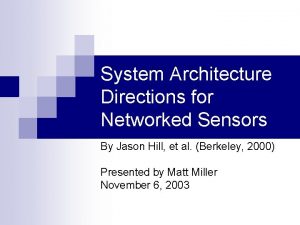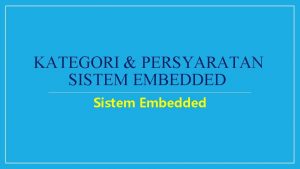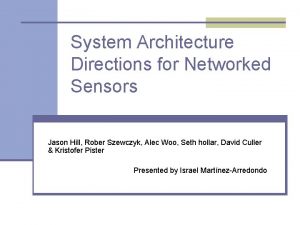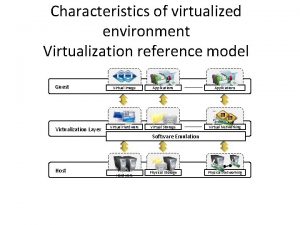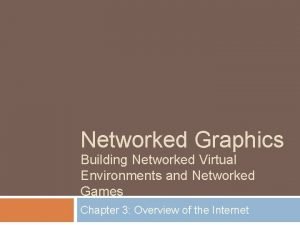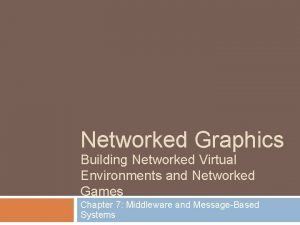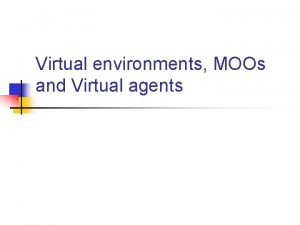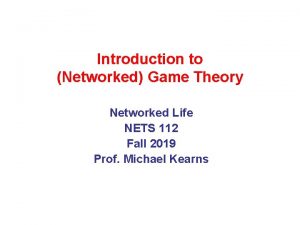Clientcontrolled Qo S Management in Networked Virtual Environments



























- Slides: 27

Client-controlled Qo. S Management in Networked Virtual Environments Patrick Monsieurs, Maarten Wijnants, Wim Lamotte Expertise Center for Digital Media Limburgs Universitair Centrum, Belgium

Overview Introduction n Related Work n Network Intelligence Architecture n Distribution of Available Bandwidth n Experimental Results n Conclusions and Future Work n

Introduction Multimedia streams consume large amounts of bandwidth n Networked multimedia applications do not scale well with large amounts of users that transmit multimedia content n Reduce downstream bandwidth usage while maintaining Qo. E n

NVE Application

Related Work Reducing sender’s quality n Spatial subdivision n Quality selection n

Reducing Sender’s Quality Receivers notify senders when downstream capacity is exceeded n Senders reduce quality of stream to reduce bandwidth n Bandwidth and quality of all receivers of the stream is reduced n

Spatial Subdivision Users in Networked Virtual Environments have a position in the environment n The environment can be subdivided in spatial regions n Each user is part of a single region and is only aware of users in nearby regions n Associate a multicast address to each region n Join or leave multicast addresses to reduce or increase bandwidth usage n

Spatial Subdivision Player A Position Player B Position Player A AOI Player B AOI

Quality Selection Spatial subdivision n Senders transmit several qualities of streams n Each quality in a region is associated with a multicast address n Receivers select one quality for each nearby region n Quality determined by distance and available bandwidth n

Quality Selection Low Quality Medium Quality High Quality

Per-stream Quality Selection Receivers select the quality of every multimedia stream n Selection based on interest manager of client application n Streams must be blocked or received inside the network before reaching the receiver n Use intelligent proxies inside the network near receivers n

Network Intelligence Architecture: Proxies Intelligent proxies are placed in the network near clients n Intelligent proxies can transcode network streams n Reduces or blocks network streams when more bandwidth is requested then available n

Network Intelligence Architecture: Proxies Bandwidth of streams is reduced based on the importance of each stream and consumed bandwidth n Importance of streams is application specific and is determined by the client application (e. g. . Nearby avatars’ audio streams are more important) n

Network Intelligence Architecture: Clients have network intelligence layer between transport and application layer n Separates application logic (such as interest management) from networking logic (such as bandwidth consumption) n

Network Intelligence Architecture

Intelligent Proxy n n Content-based “transcoders” (block/pass, lower quality, validation, …) Located near end-users (eg. DSLAM) complexity of network management located at edge of network Measures bandwidth of managed streams and available bandwidth of link to client When available bandwidth to a client is exceeded, determines which streams to block or transcode

Network Intelligence Layer n n n Replaces standard networking operations Provides interface with client’s interest manager, which periodically requests the importance of the managed network streams Communicates with intelligent proxies in the network Separates application logic from networking Associates correct transcoder to network stream (type of content is specified on creation of the socket)

Communication Between Proxy and Network Intelligence Layer Admission control: specify which streams must be managed (filter by destination port on proxy) n Creation of a stream hierarchy (next slide) n Communicating importance of streams n Multicast tunneling: NI layer monitors which multicast addresses are joined by clients n

Distribution of Available Bandwidth Hierarchy of available streams n Relative Qo. S n Components: n – Priority – Mutex – Weighted collection Priority 1 2 Weight 0. 5 Weight Position updates 0. 5 Weight wi wi Weight 0. 5 wi wi Weight wi wi wi 3 D models Mutex Video data Audio data

Distribution of Weighted Collections Stream si has weight wi between 0 and 1 n Stream si consumes bandwidth mi n Total bandwidth M = imi n Reduce bandwidth if M > available bandwidth B n h(i, b) : = highest transcoded bandwidth of stream si that is less than bandwidth b n Weighted bandwidth W = iwimi n

Distribution of Weighted Collections Initial estimate t (i) for stream si: t (i) = h(i, wimi. B/W) n i t (i ) B n Remaining bandwidth R 0 = B - it (i) n Distribute remaining bandwidth: n – Assume streams ordered by wi, w 0 highest: – Target bandwidth T(i) = h(i, t (i) + Ri) where Ri = Ri-1 – (T(i-1) – t (i-1)) for i > 0

Experimental Setup Clients Network Intelligent client Intelligent proxy Clients

Experiment 1 Maximum available bandwidth is reduced over time n Clients remain stationary in the world n Nearby clients have higher weights n

Experiment 1

Experiment 2 Fixed maximum available bandwidth n Bandwidth is not sufficient to transmit all video streams at highest quality n First, client 3 moves away from the intelligent client (reducing its weight), and later returns quickly n

Experiment 2

Conclusions Bandwidth of managed streams is adapted to maximum available bandwidth n Distribution of bandwidth is dynamic, based on the client’s interest in each stream n Separation of application logic and network logic n Intelligent proxy architecture is useful for mobile devices such as PDA’s n
 Ibm spectrum protect for virtual environments
Ibm spectrum protect for virtual environments Networked insurance agents
Networked insurance agents Classification of distributed system
Classification of distributed system System architecture directions for networked sensors
System architecture directions for networked sensors Unit 32 networked system security
Unit 32 networked system security Networked systems security
Networked systems security Fully networked vehicle
Fully networked vehicle Networked outdoor lighting
Networked outdoor lighting Networked embedded system
Networked embedded system Cs 163 uci
Cs 163 uci System architecture directions for networked sensors
System architecture directions for networked sensors Networked digital library of theses and dissertations ndltd
Networked digital library of theses and dissertations ndltd Networked sensor array
Networked sensor array Has virtual functions and accessible non-virtual destructor
Has virtual functions and accessible non-virtual destructor International business environment and operations
International business environment and operations Machine reference model
Machine reference model Busniess goals
Busniess goals Chapter 13 natural environments of europe
Chapter 13 natural environments of europe Stable prediction across unknown environments
Stable prediction across unknown environments Psychologically informed environments
Psychologically informed environments Psychologically informed environments
Psychologically informed environments Creating supportive environments smoking
Creating supportive environments smoking High quality supportive environments
High quality supportive environments External environments and accountability of schools ppt
External environments and accountability of schools ppt Known vs unknown environment
Known vs unknown environment Chapter 13 natural environments of europe
Chapter 13 natural environments of europe Jonassen constructivist learning environment
Jonassen constructivist learning environment World geography
World geography



